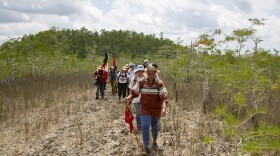You’ve bought the turkey. You’ve prepped the brine. You’ve maybe even baked and frozen the pies. You’re ready for Thanksgiving dinner.
But have you thought about being prepared for leftovers?
Leftover safety for a larger-than-life meal like Thanksgiving can be a food safety minefield. University of Florida expert Keith Schneider, professor of food safety, says it can be an often-overlooked part of the Thanksgiving meal.

Since Thanksgiving spreads are larger and have more moving parts, they tend to sit out for longer. In addition, they tend to serve huge groups of people – both of which amplify the risk of food poisoning.
“What you don’t want to do is spoil a family get-together by getting people sick,” he said. “But a few moments of planning and awareness can help prevent a big mistake.”
In general, he said, keep hot items hot and cold items cold during serving and throughout dinner – a simple-enough rule of thumb. The USDA advises never leaving food at room temperature for more than two hours.
Meat in particular can contain Clostridium perfringens, a bacterium that can cause cramps and diarrhea or more serious concerns, and it is most commonly found in food poisoning situations due to its ability to survive cooking temperatures. If food is allowed to sit out for extended periods of time, for example, past the two hours recommended by the USDA, it can multiply and result in a foodborne illness.
In general, a helpful tip could be to take a few minutes between dinner and dessert to store items away so they stay safe – and you get time to enjoy treats without the worry.
Here’s how to store Thanksgiving leftovers, dish by dish:
Turkey
The star of the show! Turkey should be cooked to 165 degrees Fahrenheit, sliced and held at 140 degrees until serving. A buffet heater tray is a nice way to keep sliced turkey at the right temperature while a large group serves themselves.
Two hours after coming out of the oven, or less, the turkey should be sliced and put in a shallow container and put in the refrigerator. The turkey should be cooler by then – around 140 degrees Fahrenheit – don’t put hot food into the refrigerator or it will heat up the ambient temperature of the fridge and prompt other food to spoil, Schneider said.
This advice also applies to ham or other non-traditional cuts of meat, like beef brisket.
In the fridge, cooked meat is safe for between three and five days. Turkey and ham can also be put in freezer bags and frozen for up to six months.
Gravy
Gravy can be tricky when it comes to food safety, Schneider said. It should be cooked until 165 degrees Fahrenheit and held at 135 degrees or higher for serving. When guests are done, put it into small, shallow containers and put it in the fridge.
People tend to put gravy in large, tall containers, which causes the outside to cool while the inside stays extremely hot. This leads to pathogens growing that could cause food poisoning. Refrigerators are good at keeping food cold but not good at removing heat. Using shallow containers will speed up the cooling process, Schneider said.
Stuffing
Stuffing should be cooked separate from the turkey for maximum safety, but if you have a cooking tradition you must adhere to, here’s how to do it safely.
After the turkey cooks to 165 degrees, with the stuffing in the cavity, remove the stuffing and put it in a separate dish and reheat it again in the oven until 165 degrees. Since the inside of a bird heats up last, it’s likely the stuffing won’t get hot enough while inside the turkey, so reheating is critical.
Once the stuffing is served and bellies are full, place it in a shallow dish and put it in the refrigerator or freeze it.
This also applies to dishes that are wetter and mixed with multiple ingredients, like mashed potatoes, cut potatoes and casseroles.
Be aware that wet dishes like green bean casserole will cool off slower than dryer dishes. Smaller-cut potatoes will also cool faster than larger chunks of potatoes, which means they need to be refrigerated faster.
Roasted vegetables
While these mostly follow the same principles as stuffing, the high moisture content presents some additional challenges.
Once they’ve begun to cool, they need to be put in the refrigerator within two hours. Keeping them hot during serving and throughout dinner via a buffet heater tray or chafing dish helps with this.
Salad
Salads should be kept chilled until serving and stored away in the refrigerator as soon as possible after dinner – two hours or less after they’ve come out of the fridge. Given their high moisture content and the lack of cooking, they can be a key culprit for dinner-related food poisoning.
“If you’re leaving salads out, that can be an issue if someone eats them for leftovers the next day,” he said.
Pies
Food safety varies based on the type of pie – the wetter, the more cautious you need to be.
Pies like pecan have essentially no water and are low-risk, Schnieder said.
But other pies like pumpkin have lots of moisture and should not be left at room temperature for more than two hours.
Protect yourself and your family this year with a bit of careful planning for not only Thanksgiving dinner but the leftovers that come afterward.
ABOUT UF/IFAS: The mission of the University of Florida Institute of Food and Agricultural Sciences (UF/IFAS) is to develop knowledge relevant to agricultural, human and natural resources and to make that knowledge available to sustain and enhance the quality of human life. With more than a dozen research facilities, 67 county Extension offices, and award-winning students and faculty in the UF College of Agricultural and Life Sciences, UF/IFAS brings science-based solutions to the state’s agricultural and natural resources industries, and all Florida residents.
WGCU is your trusted source for news and information in Southwest Florida. We are a nonprofit public service, and your support is more critical than ever. Keep public media strong and donate now. Thank you.







